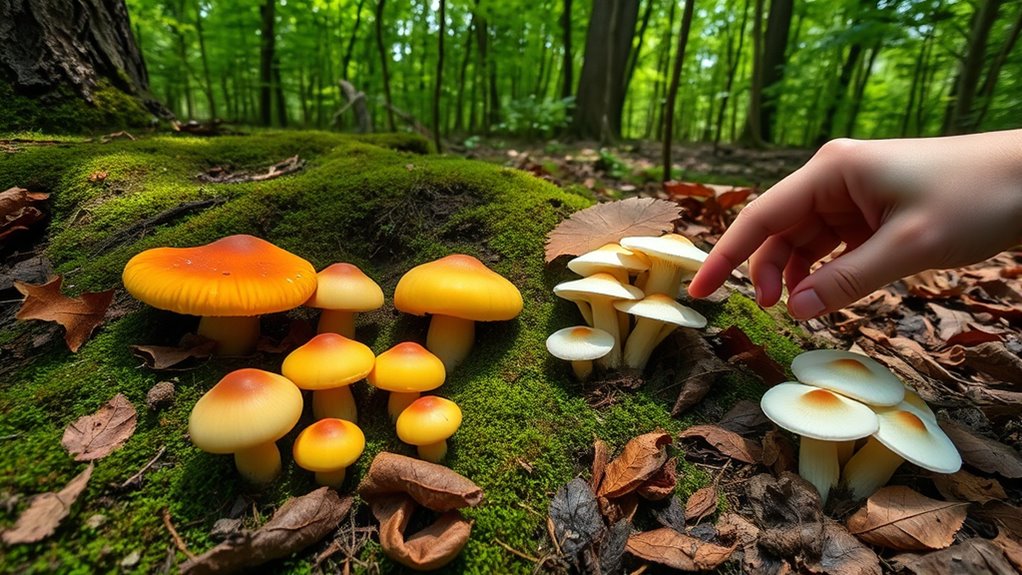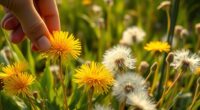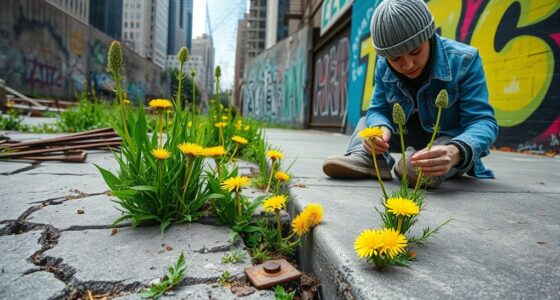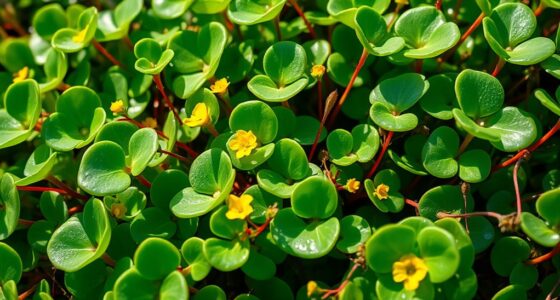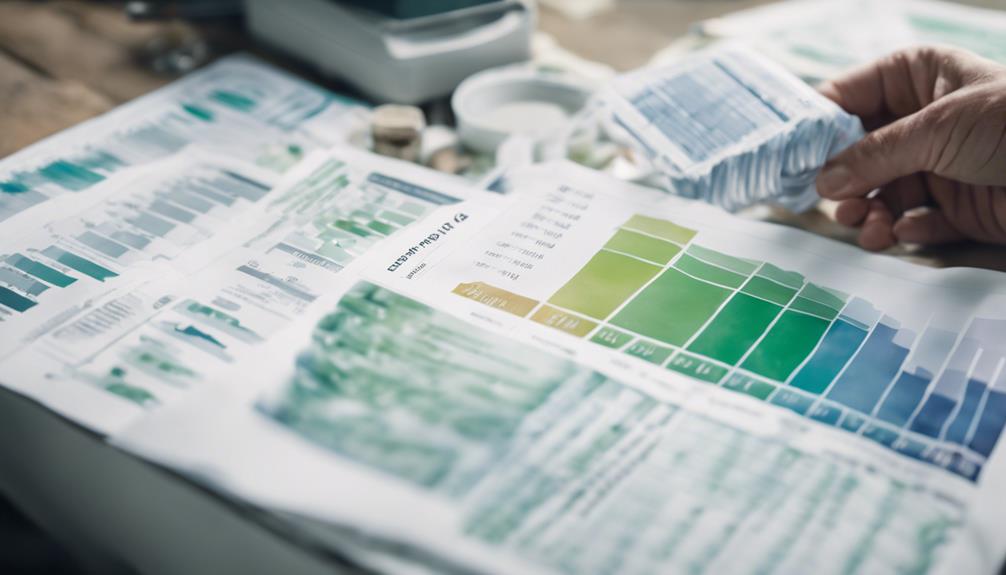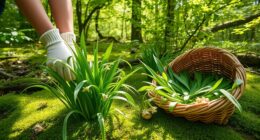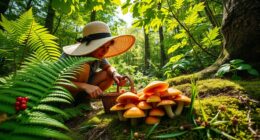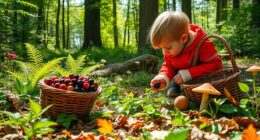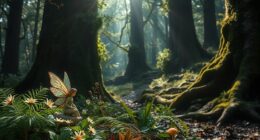To stay safe while foraging, carefully examine mushrooms for key features like cap shape, gill attachment, and spore color, and always compare with trusted guides. Beware of toxic look-alikes such as false morels or deadly Amanitas. Use spore prints and consult local experts or resources to confirm identifications. Follow legal rules and handle mushrooms hygienically. If you want to learn detailed tips on avoiding poisonous varieties, keep exploring these essential foraging practices.
Key Takeaways
- Learn to identify key features like cap shape, gill attachment, and spore print color to distinguish edible mushrooms from toxic look-alikes.
- Avoid tasting or consuming mushrooms unless you are absolutely sure of their species, and always confirm with reliable field guides.
- Be aware of toxic signs such as red coloration, blue staining, or milky exudate, which indicate potential danger.
- Follow local regulations and only forage in permitted areas, practicing sustainable harvesting to protect ecosystems.
- Handle and store mushrooms carefully, using clean tools and proper preservation methods to prevent bacterial growth and food poisoning.
Proper Techniques for Identifying Edible Mushrooms
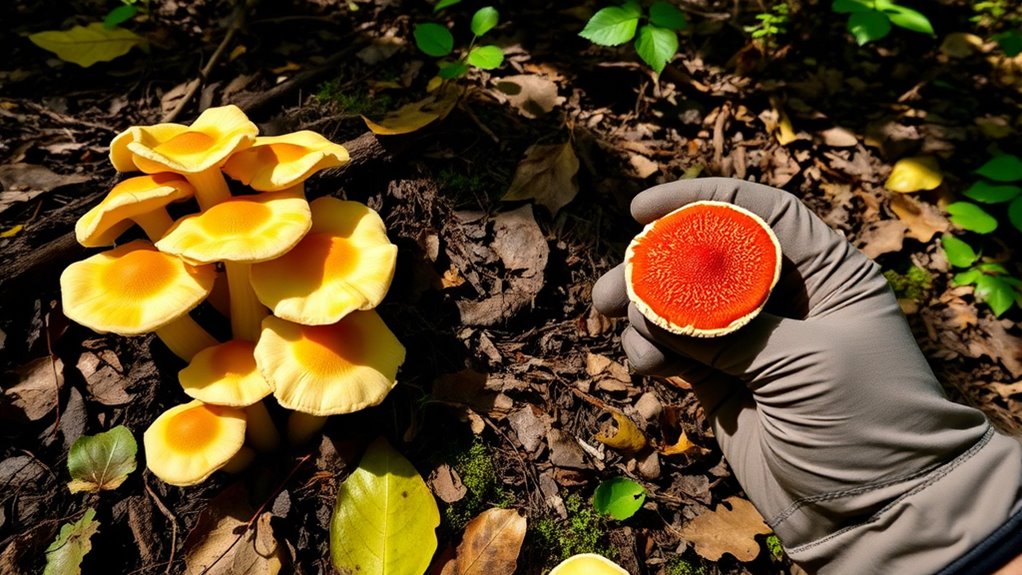
To identify edible mushrooms safely, you need to master proper techniques that focus on observing key physical and ecological features. Start by examining the mushroom’s macromorphological traits: note the shape, size, and color of the cap, along with its texture. Check the stem’s length, thickness, and color, and look for any rings or veils.
Observe the hymenophore—whether it has gills, pores, or teeth—as this helps narrow down species. Pay attention to odors and tastes, but never taste unknown mushrooms. Consider ecological clues like habitat, substrate, and association with specific plants or trees.
Understanding these features, combined with consulting field guides and resources, enhances your ability to distinguish edible fungi safely. Accurate observation minimizes the risk of misidentification and promotes safe foraging practices.
Recognizing Toxic Mushrooms and Their Look-Alikes
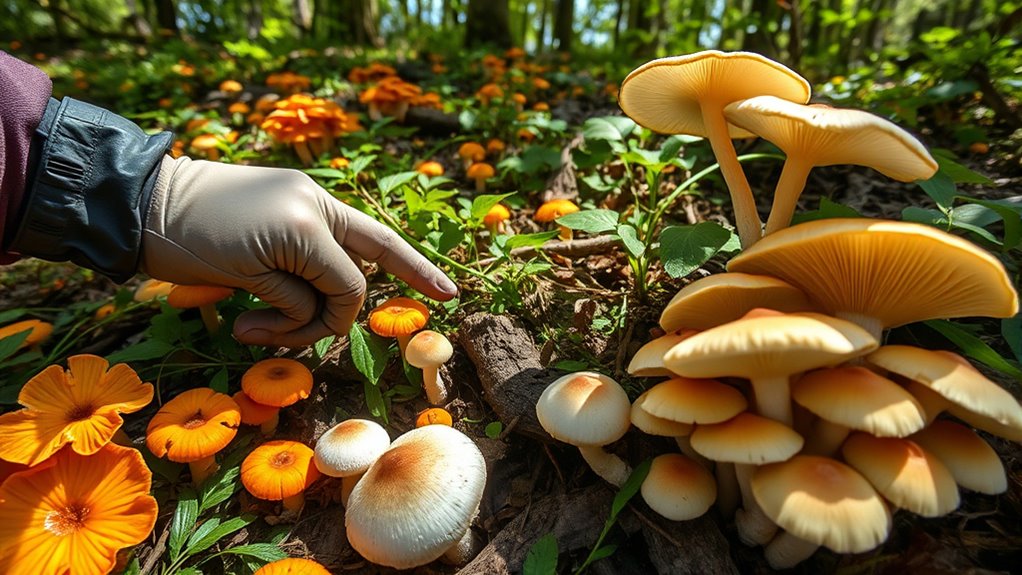
Recognizing toxic mushrooms and their look-alikes is essential for safe foraging, as many poisonous species closely resemble edible ones. For example, false morels have wavy, crumpled caps and nearly solid stems, unlike true morels with pitted caps and hollow stems. False morels contain gyromitrin, which can cause severe poisoning, so always verify before eating. Being aware of vetted mushroom products and safe identification techniques can help prevent accidental ingestion of toxic varieties. Additionally, learning to identify distinctive features such as color, texture, and habitat can prevent dangerous mistakes. The environmental cues, like growth location and season, can also be crucial in correctly identifying safe versus toxic mushrooms. Recognizing mushroom toxins and understanding which species carry them is vital for avoiding health emergencies. Boletes with red coloration or blue staining when cut are likely toxic, and their sponge-like pores distinguish them from safe varieties. Milk caps exude milky liquid that can be acrid and toxic, especially when young. Poisonous mushrooms like Jack-o’-lanterns, green-spored Lepiota, and Clitocybe dealbata often grow in lawns or woodlands; their early identification is critical to avoid health emergencies. Always examine features carefully to avoid dangerous mistakes.
Consulting Resources and Experts Before Foraging
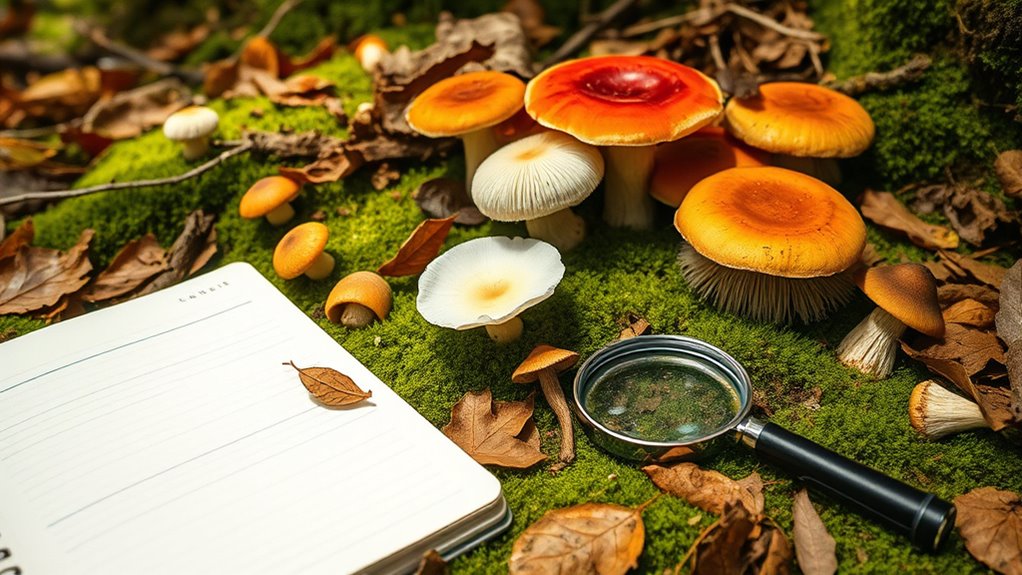
Before heading out to forage, tapping into reliable resources and expert knowledge can make all the difference. Participating in workshops led by local experts offers hands-on experience and personalized advice, helping you identify safe mushrooms. Experts like mushroom enthusiasts with diverse backgrounds provide regional insights essential for recognizing local species. Joining local foraging groups or attending community workshops builds your network and boosts your confidence. Online platforms, such as mycological associations and consultation services, connect you with specialists for tailored guidance. proper identification methods are vital for distinguishing edible from poisonous mushrooms and should be a core part of your education. These resources often include digital forums and blogs that keep you updated on safety tips and new discoveries. Utilizing toxic mushroom identification is crucial for safe foraging and avoiding dangerous look-alikes. Developing an understanding of regulations and guidelines can help you ensure sustainable harvesting practices and stay within legal boundaries. Staying informed about local mushroom species enhances your ability to recognize safe varieties and avoid harmful ones. Incorporating Gold IRA regulations awareness into your research can help you understand how to protect your investments and avoid costly mistakes, paralleling the importance of accurate mushroom identification. Consulting experts before foraging guarantees you learn sustainable practices, avoid mistakes, and develop a deeper understanding of your environment, making your foraging safer and more enjoyable.
Understanding and Using Spore Prints and Gill Patterns

Understanding and using spore prints and gill patterns are essential skills for accurate mushroom identification. Spore prints reveal the color of spores, which helps distinguish species. To create a spore print, place the mushroom cap gills down on white or black paper and leave it overnight. The spores fall, forming a pattern that’s easy to analyze. Different spores, like pinkish for blewits or rusty brown for Cortinarius, indicate specific species. Gill patterns—how the gills attach or their shape—also provide key clues. Attachable, free, or decurrent gills help differentiate mushrooms further. Combining spore print colors with gill structure enhances identification accuracy. Use these visual cues alongside field guides and other methods to reliably identify edible versus poisonous varieties, reducing your risk during foraging. Additionally, understanding the spore print color and its significance can prevent dangerous misidentifications, especially when combined with knowledge of gill attachment and other morphological features. Recognizing the gill shape can further refine your identification process and avoid potentially deadly mistakes. Paying attention to spore print consistency can also help identify unique or atypical species and avoid common misclassification errors. Being aware of the spore deposit consistency can reveal subtle differences that are crucial for safe foraging.
Navigating Legal Regulations and Permits for Foraging Areas
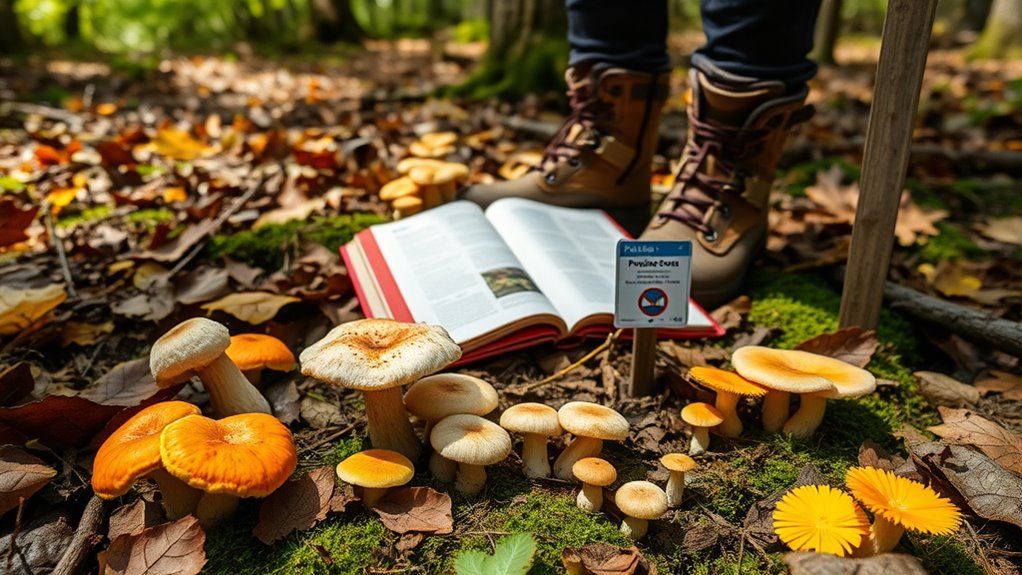
Knowing how to identify mushroom species is just one part of safe foraging; you also need to be aware of the legal regulations and permit requirements in your area. Many public lands restrict or prohibit mushroom picking, so always check local rules before you go. For example, Pennsylvania state parks allow personal foraging but ban commercial harvesting. BLM lands typically permit collecting up to one gallon per day per person, but commercial harvesting isn’t allowed. Regulations can vary widely by region, so research your specific area. Be aware that regulations on foraging can include restrictions on certain species to protect local ecosystems. Some locations require permits for collecting, especially for commercial purposes, while others do not. Always contact land management offices or local authorities to confirm current rules. Ignoring these regulations can lead to fines or bans, so stay informed and compliant.
Practicing Sustainable and Responsible Foraging Habits
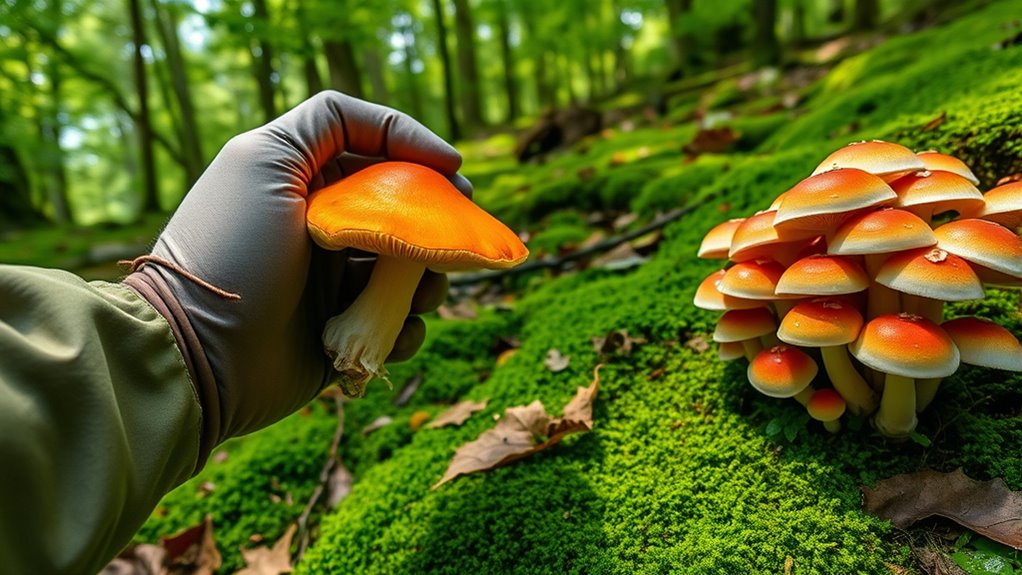
Practicing sustainable and responsible foraging habits is essential to protect mushroom populations and preserve the health of their ecosystems. You should harvest only half of a mushroom patch to allow spores to disperse and ensure future growth. Using open-air containers like loose weave baskets or mesh bags to carry your harvest helps spores fall and promote reproduction. Stick to established trails and avoid trampling sensitive areas to prevent damage to young mushrooms and nearby plants. Leave behind older mushrooms that have already released spores, supporting natural cycles. Minimize soil disturbance to protect underground mycelium networks, and dispose of waste properly to avoid pollution. Additionally, incorporating fungal ecology into your knowledge can help you understand how fungi interact with plant roots, emphasizing the importance of preserving the entire ecosystem. Understanding mycorrhizal relationships further highlights the interconnected nature of these organisms and the environment. Being aware of refrigerant management and its environmental impact can also inspire more eco-conscious foraging practices, promoting sustainability in all aspects of nature interactions. Recognizing ecosystem balance is crucial for maintaining healthy environments where fungi thrive naturally. Incorporating knowledge of soil health can also enhance sustainable harvesting by understanding how fungi contribute to nutrient cycling and ecosystem resilience.
Ensuring Clean and Safe Handling During Collection
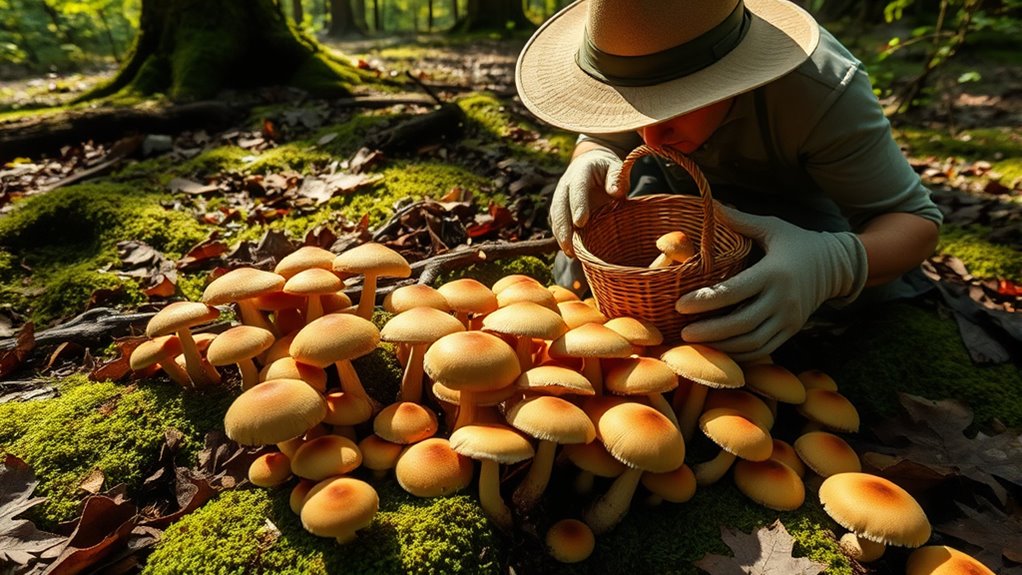
To guarantee your mushroom harvest remains safe and fresh, it’s essential to handle your collection with hygienic techniques. Use breathable baskets or mesh bags instead of plastic, which traps moisture and causes decay. Proper handling techniques can significantly reduce the risk of contamination and spoilage. Ensure all tools are clean and free of contaminants before harvesting. Wearing gloves can prevent oils from your skin from affecting the mushrooms’ quality. Handle each mushroom gently to avoid bruising, which can lead to spoilage. Avoid collecting from contaminated areas like lawns, roadsides, or old dump sites, as these can contain pollutants or pesticides. Inspect mushrooms for damage or signs of rot, and only pick young, fresh specimens. Proper handling minimizes contamination risks and preserves mushroom quality, making your foraged mushrooms safer for consumption. Additionally, using appropriate storage techniques can help maintain freshness and prevent spoilage during transport and storage. Hygienic harvesting practices are essential to prevent the transfer of bacteria and other pathogens, ensuring your mushrooms stay safe and nutritious until they reach your table. Employing proper post-harvest handling practices ensures your mushrooms stay safe and nutritious until they reach your table. It’s also beneficial to educate yourself on mushroom identification to avoid accidental harvesting of toxic varieties.
Proper Storage and Preservation of Foraged Mushrooms
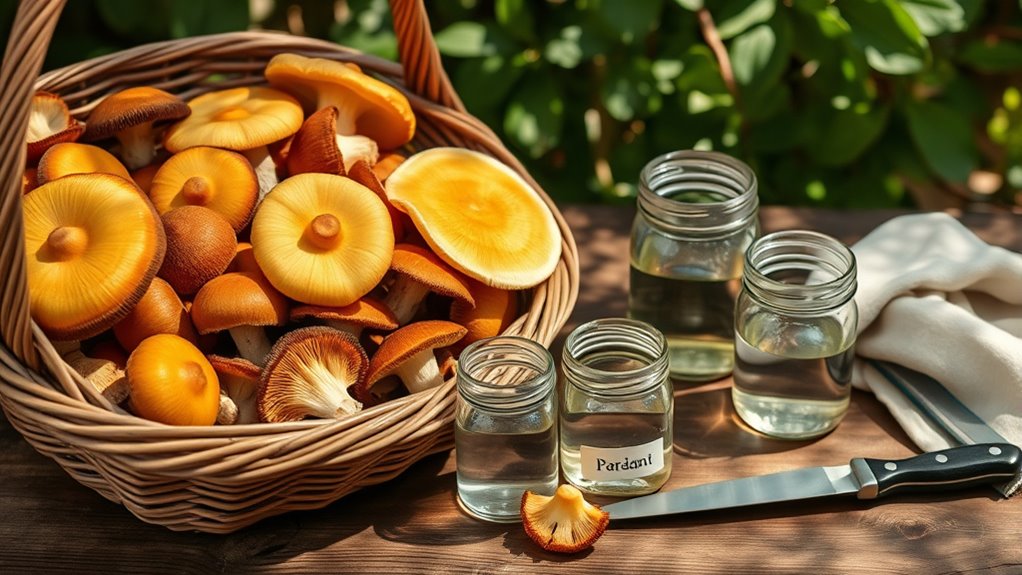
Proper storage and preservation are essential to keep your foraged mushrooms fresh, safe, and flavorful for longer periods. After harvesting, use vacuum or forced air cooling, followed by room cooling, to maintain freshness. Keep mushrooms at around 3°C to slow browning and microbial growth, while minimizing water loss and respiration. Creating a cozy farmhouse bedroom can help provide an ideal environment for storing certain delicate varieties. Store them in punnet containers to preserve quality, and dark conditions help retain antioxidants. For drying, air drying in a well-ventilated space or using a food dehydrator quickly reduces moisture, extending shelf life from days to months. Proper mushroom preservation techniques like freezing works best after cleaning and blanching, with airtight containers preventing freezer burn. Proper canning or brining creates long-lasting preserves. Regularly check stored mushrooms for moisture, spoilage, and changes in appearance to ensure quality and safety.
Being Aware of Common Foodborne Risks and Symptoms

Being aware of common foodborne risks associated with mushroom foraging is essential for ensuring your safety. Mushrooms can carry pathogens like *Salmonella*, *Listeria*, and *Staphylococcus*, which cause illnesses if ingested. A recent development in safe foraging practices emphasizes the importance of understanding electric power generation when considering the energy needs during extended outdoor activities, including mushroom collecting trips. Misidentifying toxic species can lead to severe health issues, including stomach pain, vomiting, hallucinations, and organ damage. Improper handling and storage can promote bacterial growth, even in canned mushrooms. Some toxins, like staphylococcal enterotoxins, resist heat and cooking, so they remain dangerous. Wild mushrooms pose significant risks because distinguishing edible from toxic varieties is challenging. Symptoms of poisoning often include nausea, diarrhea, dizziness, and sometimes long-term organ damage. Recognizing these risks helps you avoid dangerous mushrooms and seek prompt medical attention if symptoms occur.
Promoting Environmental Conservation While Foraging

Promoting environmental conservation while foraging is essential to preserve the delicate balance of ecosystems. You can do this by minimizing soil disturbance and avoiding soil compaction, which harms underground mycelium.
Respect endangered mushroom species by learning which ones are rare and refraining from overharvesting. Always carry out your waste to prevent littering and protect habitat quality.
Recognize the impacts of climate change on mushroom populations, adjusting your practices accordingly. Support urban foraging to help city dwellers connect with nature and contribute to ecosystem health.
Use responsible harvesting techniques, like leaving some mushrooms behind and only picking mature specimens to ensure future growth. Wearing appropriate gear and avoiding damage to vegetation also helps sustain the environment for generations to come.
Frequently Asked Questions
How Can I Distinguish Between Edible and Toxic Look-Alike Mushrooms?
To tell apart edible mushrooms from their toxic look-alikes, pay attention to color, shape, and texture. Edible varieties often have distinctive features like bright colors, specific shapes, or unique textures.
Observe gills versus pores, bruising reactions, and growth environments. Always use reliable guides, avoid all-white mushrooms, and consider consulting an expert.
What Are the Most Common Edible Mushroom Species to Forage Safely?
You want to know about common edible mushrooms for safe foraging. Focus on species like porcini, chanterelles, and morels, which are easily recognizable and prized for their flavor.
Cultivated options like button, portobello, and shiitake are also safe and widely available.
Always learn key identifying features, avoid look-alikes, and double-check with expert guides or local foraging groups to guarantee you’re collecting safe, edible mushrooms.
Are There Specific Tools Recommended for Safe Mushroom Harvesting?
You should use specific tools for safe mushroom harvesting, like a sharp knife to make clean cuts without damaging the mycelium. A brush or soft toothbrush helps you gently clean dirt off the mushrooms, preventing contamination.
Carrying mushrooms in a dedicated harvesting basket keeps them organized and prevents bruising. Always bring a field guide or a reference app to identify species accurately, ensuring you pick only safe, edible varieties.
How Do Weather and Seasonality Affect Mushroom Identification?
Weather and seasonality dramatically shape your mushroom hunts, almost like magic spells that conjure or vanish species. Rainfall triggers abundance, while drought can wipe out entire foraging seasons.
Temperature swings make identifying mushrooms tricky, and seasonal changes influence their appearance and toxicity.
What Are the Signs of Mushroom Poisoning to Watch for After Foraging?
After foraging, you should watch for signs like nausea, vomiting, stomach cramps, and diarrhea, which appear within 15 to 30 minutes.
You might experience dizziness, headache, or sweating.
In some cases, symptoms include rapid heartbeat, hallucinations, or difficulty breathing.
Keep an eye out for delayed severe symptoms like liver or kidney issues, which can develop hours later.
Seek medical help immediately if you suspect poisoning to prevent serious health risks.
Conclusion
Remember, foraging is like walking a delicate tightrope—balancing between the thrill of discovery and the danger of poison. By mastering identification, consulting experts, and respecting nature’s rules, you become a vigilant guardian of the forest’s secrets. Trust your senses and stay educated; otherwise, your adventure could turn into a treacherous maze. With careful steps and respect, you’ll uncover nature’s hidden treasures safely, turning every mushroom hunt into a symphony of safe, sustainable foraging.

